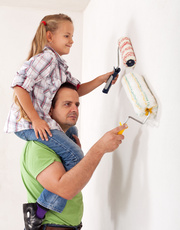Simple and Safe DIY Tasks to Do With Your Children
As a father of three pre-teens, I understand the importance of spending quality time with my kids while also teaching them valuable skills to help get them ready for the real world. That’s why I love doing simple and safe DIY tasks with them around the house.
Not only do these activities provide a fun bonding experience, but they also help to build their confidence and independence which will come in handy when they’re old enough to have their own homes. So today I will share some easy and safe DIY tasks that you can do with your children, to help set them up for success.
Installing Window Blinds
One DIY/home decor task that is simple and safe to do with the help of your little ones is installing a new set of roller blinds.
This task can be done in just a few steps, and it’s a great way to teach your children about measuring and safely introduce them to some power tools (under careful supervision of course).
First, measure the width and height of the window where you want to install the blinds.
Next, purchase a set of blinds that fit those measurements and wait for your new blinds to be delivered.
Once you receive your blinds, mount the brackets onto the window frame using a power drill and screws.
Finally, insert the blinds into the brackets and test them to make sure they open and close smoothly.
Hanging Shelves
Another great DIY task to do with your kids is hanging a new set of shelves, this will be especially fun installing in their bedroom as they will have a personal stake in the task.
Putting up a shelf with your children will only take a few minutes, which is ideal for holding their attention and it is a great way to teach your kids about using a spirit level, screwdrivers, and a tape measure.
First, decide where you want to hang the shelves and measure the distance between each shelf.
Next, using a level, mark where the brackets should go on the wall.
Then, using a power drill, drill holes where the brackets will need to be attached to the wall.
After that, use a screwdriver and some screws to secure the brackets to the wall.
Finally, slide the shelf onto the brackets and make sure its level using the spirit level before securing it with screws.
Painting a Room
Painting a room is another DIY task that is safe and fun to do with your children, aside from the potential to make a mess, but that’s what floor covers are for.
This task will be a perfect way to teach your children about colour co-ordination as well as teamwork skills as they work together.
First, choose a room to paint (ideally a bed room or common area), then take a trip to your local hardware store to pick out the colours you all want to use, as well as grab some brushes and rollers.
Once you have your paints and brushes at the ready, cover the floors and furniture with floor covers or old sheets you don’t mind getting messy.
Next, use some tape to cover up any areas you don’t want to get paint on, like electrical sockets or skirting boards.
Finally, using your rollers and brushes, carefully paint the walls as a team, with younger children doing lower areas, older children doing middle areas and parents doing higher areas. Make sure to take breaks and have fun with your kids during the process!
Planting a Garden
If you have a green thumb and want to pass that onto your children, planting a garden is a great DIY task to do with your children outside in your garden.
Planting a family garden is a fantastic way to teach your kids about nature and responsibility, and a great way to get them interested in biology before starting science lessons.
First, take your children out to your garden and choose a sunny spot to plant your family garden.
Once you’ve chose an area, clear the space of any weeds or garden debris and remove the grass to get to the soil.
Next, dig small holes in the soil for each plant or seed, making sure to leave space for the plants to grow.
Finally, plant the seeds or plants in their fresh holes (making sure to add extra soil to fill any space left),and water them regularly. Make sure to involve your kids in regular watering sessions to teach them about the different types of plants you’re growing and give them some responsibility.




